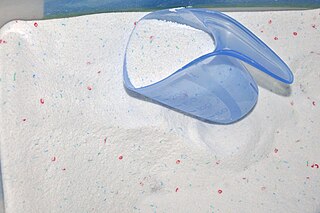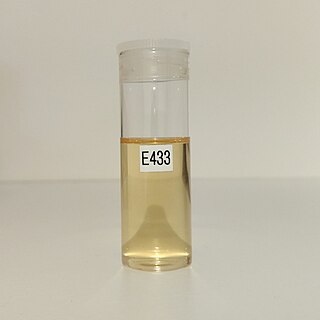
A detergent is a surfactant or a mixture of surfactants with cleansing properties when in dilute solutions. There are a large variety of detergents, a common family being the alkylbenzene sulfonates, which are soap-like compounds that are more soluble in hard water, because the polar sulfonate is less likely than the polar carboxylate to bind to calcium and other ions found in hard water.

Surfactants are chemical compounds that decrease the surface tension or interfacial tension between two liquids, a liquid and a gas, or a liquid and a solid. The word "surfactant" is a blend of surface-active agent, coined c. 1950. As they consist of a water-repellent and a water-attracting part, they enable water and oil to mix; they can form foam and facilitate the detachment of dirt.
A lysis buffer is a buffer solution used for the purpose of breaking open cells for use in molecular biology experiments that analyze the labile macromolecules of the cells. Most lysis buffers contain buffering salts and ionic salts to regulate the pH and osmolarity of the lysate. Sometimes detergents are added to break up membrane structures. For lysis buffers targeted at protein extraction, protease inhibitors are often included, and in difficult cases may be almost required. Lysis buffers can be used on both animal and plant tissue cells.

Lecithin is a generic term to designate any group of yellow-brownish fatty substances occurring in animal and plant tissues which are amphiphilic – they attract both water and fatty substances, and are used for smoothing food textures, emulsifying, homogenizing liquid mixtures, and repelling sticking materials.
In organic chemistry, ethoxylation is a chemical reaction in which ethylene oxide adds to a substrate. It is the most widely practiced alkoxylation, which involves the addition of epoxides to substrates.

Laundry detergent is a type of detergent used for cleaning dirty laundry (clothes). Laundry detergent is manufactured in powder and liquid form.

Triton X-100 is a nonionic surfactant that has a hydrophilic polyethylene oxide chain and an aromatic hydrocarbon lipophilic or hydrophobic group. The hydrocarbon group is a 4-(1,1,3,3-tetramethylbutyl)-phenyl group. Triton X-100 is closely related to IGEPAL CA-630, which might differ from it mainly in having slightly shorter ethylene oxide chains. As a result, Triton X-100 is slightly more hydrophilic than Igepal CA-630 thus these two detergents may not be considered functionally interchangeable for most applications.

Polysorbate 80 is a nonionic surfactant and emulsifier often used in pharmaceuticals, foods, and cosmetics. This synthetic compound is a viscous, water-soluble yellow liquid.
Sorbitan monostearate is an ester of sorbitan and stearic acid and is sometimes referred to as a synthetic wax.

NP-40 is a commercially available detergent with CAS Registry Number 9016-45-9. NP-40 is an ethoxylated nonylphenol for non-ionic surfactants and can act as emulsifier and demulsifier agent.
Nonoxynols also known as nonaethylene glycol or polyethylene glycol nonyl phenyl ether are mixtures of nonionic surfactants used as detergents, emulsifiers, wetting agents or defoaming agents. The most commonly discussed compound nonoxynol-9 is a spermicide, formulated primarily as a component of vaginal foams and creams. Nonoxynol was found to metabolize into free nonylphenol when administered to lab animals. Arkopal-N60, with on average 6 ethylene glycol units is a related used surfactant.

Sorbitan is a mixture of isomeric organic compounds derived from the dehydration of sorbitol and is an intermediate in the conversion of sorbitol to isosorbide. Sorbitan is primarily used in the production of surfactants such as polysorbates; which are important emulsifying agents, with a total annual demand of more than 10,000 tons in 2012.

Sorbitan tristearate is a nonionic surfactant. It is variously used as a dispersing agent, emulsifier, and stabilizer, in food and in aerosol sprays. As a food additive, it has the E number E492. Brand names for polysorbates include Alkest, Canarcel, and Span. The consistency of sorbitan tristearate is waxy; its color is light cream to tan.

Cetomacrogol 1000 is the tradename for polyethylene glycol hexadecyl ether, which is nonionic surfactant produced by the ethoxylation of cetyl alcohol to give a material with the general formula HO(C2H4O)nC16H33. Several grades of this material are available depending on the level of ethoxylation performed, with repeat units (n) of polyethylene glycol varying between 2 and 20. Commercially it can be known as Brij 58 (when n=20) or Brij 56 (when n=10). Brij is a trademark of Croda International.
In molecular biology, TBST is a mixture of tris-buffered saline (TBS) and Polysorbate 20. Polysorbate 20 is also known as Tween 20, a commercial brand name. It is a common detergent used in many buffers for washing nitrocellulose membrane in western blotting and microtiter plate wells in ELISA assays. Tris is a buffer that maintains a pH of 7–9.2.
IGEPAL CA-630 is a nonionic, non-denaturing detergent. Its official IUPAC name is octylphenoxypolyethoxyethanol. IGEPAL is a registered trademark of Rhodia.
Paint has four major components: pigments, binders, solvents, and additives. Pigments serve to give paint its color, texture, toughness, as well as determining if a paint is opaque or not. Common white pigments include titanium dioxide and zinc oxide. Binders are the film forming component of a paint as it dries and affects the durability, gloss, and flexibility of the coating. Polyurethanes, polyesters, and acrylics are all examples of common binders. The solvent is the medium in which all other components of the paint are dissolved and evaporates away as the paint dries and cures. The solvent also modifies the curing rate and viscosity of the paint in its liquid state. There are two types of paint: solvent-borne and water-borne paints. Solvent-borne paints use organic solvents as the primary vehicle carrying the solid components in a paint formulation, whereas water-borne paints use water as the continuous medium. The additives that are incorporated into paints are a wide range of things which impart important effects on the properties of the paint and the final coating. Common paint additives are catalysts, thickeners, stabilizers, emulsifiers, texturizers, biocides to fight bacterial growth, etc.
Sorbitan monopalmitate (SMP) is a food additive, permitted by the EU. It is entry E495 in the E number list of permitted food additives. It is also known under the trade name Span 40.

Fabric treatments are processes that make fabric softer, or water resistant, or enhance dye penetration after they are woven. Fabric treatments get applied when the textile itself cannot add other properties. Treatments include, scrim, foam lamination, fabric protector or stain repellent, anti microbial and flame retardant.












